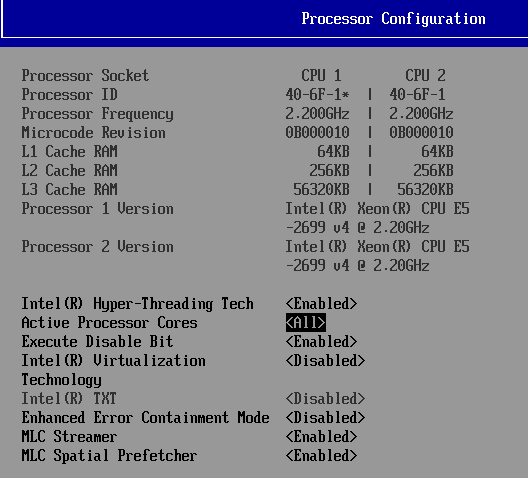The Intel Xeon E5 v4 Review: Testing Broadwell-EP With Demanding Server Workloads
by Johan De Gelas on March 31, 2016 12:30 PM EST- Posted in
- CPUs
- Intel
- Xeon
- Enterprise
- Enterprise CPUs
- Broadwell
Benchmark Configuration and Methodology
All of our testing was conducted on Ubuntu Server 14.04 LTS. Admittedly, that might seem like an old distribution to some of our readers, but enterprises prefer stability and support over the latest software. We did upgrade this distribution to the latest release (14.04.4), which gives us more extensive hardware support.
To make things more interesting, we tested 4 different SKUs and included the previous generation Xeon E5 v3s, the Xeon E5-2697v2 (high end Ivy Bridge EP), and the E5-2690 (high end Sandy Bridge EP). We even included the Xeon X5680 for comparison reasons. The Xeon E5-2695 v4 is interesting to compare to the Xeon E5-2699 v3 as it has the same core count and more or less the same clockspeed. That way we could quantify the improvement that the Broadwell core offers over the Haswell core.
Last but not least, we want to note how the performance graphs have been color-coded. Orange is the latest generation (v4), dark blue the previous one (v3), and light blue is the generation that the current (v4) is (arguably) supposed to replace (Xeon E5 v1).
Intel's Xeon E5 Server – S2600WT (2U Chassis)
| CPU | Two Intel Xeon processor E5-2699v4 (2.2 GHz, 22c, 55MB L3, 145W) Two Intel Xeon processor E5-2695v4 (2.1 GHz, 18c, 45MB L3, 145W) Two Intel Xeon processor E5-2699v3 (2.3 GHz, 18c, 45MB L3, 145W) Two Intel Xeon processor E5-2695v3 (2.3 GHz, 14c, 35MB L3, 120W) Two Intel Xeon processor E5-2667v3 (3.2 GHz, 8c, 20MB L3, 135W) |
| RAM | 128GB (8x16GB) Kingston DDR-2400 |
| Internal Disks | 2x Intel SSD3500 400GB |
| Motherboard | Intel Server Board Wildcat Pass |
| Chipset | Intel Wellsburg B0 |
| BIOS version | 1/28/2016 |
| PSU | Delta Electronics 750W DPS-750XB A (80+ Platinum) |
The typical BIOS settings can be seen below.
SuperMicro 6027R-73DARF (2U Chassis)
| CPU | Two Intel Xeon processor E5-2697 v2 (2.7GHz, 12c, 30MB L3, 130W) Two Intel Xeon processor E5-2690 (2.9GHz, 8c, 20MB L3, 135W) |
| RAM | 128GB (8x16GB) Samsung at 1866 MHz |
| Internal Disks | 2x Intel SSD3500 400GB |
| Motherboard | SuperMicro X9DRD-7LN4F |
| Chipset | Intel C602J |
| BIOS version | R 3.0a (December the 6th, 2013) |
| PSU | Supermicro 740W PWS-741P-1R (80+ Platinum) |
All C-states are enabled in both the BIOS.
Other Notes
Both servers are fed by a standard European 230V (16 Amps max.) power line. The room temperature is monitored and kept at 23°C by our Airwell CRACs.











112 Comments
View All Comments
patrickjp93 - Friday, April 1, 2016 - link
Knight's Landing: 730 mm^2, also on the 14nm platformextide - Friday, April 1, 2016 - link
Is it really that big..? Wow, I knew it was big, but didn't know it was that big. Got a source on that?Kevin G - Friday, April 8, 2016 - link
I'll second a link for a source. I knew it'd be big but that big?extide - Friday, April 1, 2016 - link
I know you meant Reticle, but that was a pretty funny typo, heh.Kevin G - Friday, April 8, 2016 - link
Autocorrect has gotten the best of me yet again.extide - Friday, April 1, 2016 - link
And, I know how big GM200 and Fiji are, but I am talking about big GPU's on 14/16nm. All signs are currently pointing to <300mm^2 for the first round of 14/16nm GPU's.lorribot - Thursday, March 31, 2016 - link
Given the way Microsoft and others are now licensing by the core and in large non splitable packages (Windows 2016 Datacenter is in blocks of 16 cores, a dual socket server with 44 cores would need 48 core licences) the increasing core count has limited appeal over small numbers of faster cores when looking at virtualised environments.Those still in the physical world will still have to pay per core but may have to buy 4 std Windows licenses.
when it comes to doing your testing, it should reflect these costs and compare total bang per buck when dealing with performance.
Red Hat still licences per socket but don't be surprised if they go per core too.
JohanAnandtech - Friday, April 1, 2016 - link
Back in 2008, I had a sales person explaining the license models of Microsoft to me in our lab. From that point on, we have invested most of our time and resources in linux server software. :-Dextide - Friday, April 1, 2016 - link
Enterprise linux isn't free, either ya knowrahvin - Friday, April 1, 2016 - link
Support isn't free on the FOSS side but the software is. Redhat is never going to charge more per "cores" for support, that's ridiculous and would result in rivals stealing their support contracts. If licensing costs are that bad that you are dumping hardware you really should be looking at moving services to Linux and Visualizing the windows servers so you can limit the core count and provide more horsepower.Anyone putting Microsoft on bare hardware these days is nuts. Although the consolation is that they get to pay MS's exorbitant tax on software. Linux should be the core component of any IT services and virtualized servers where you need proprietary server software.